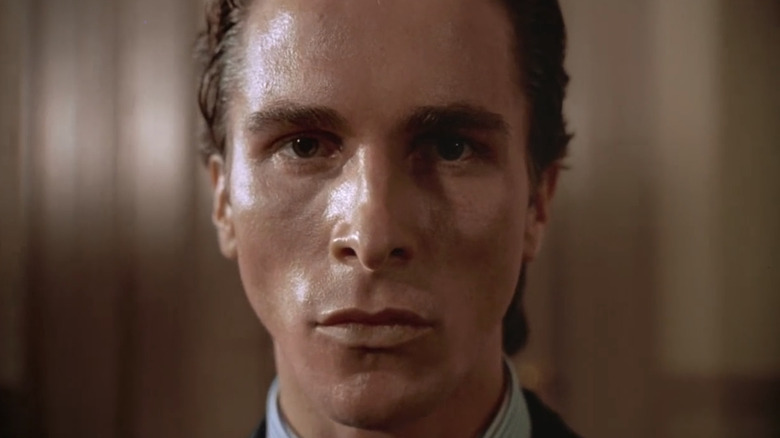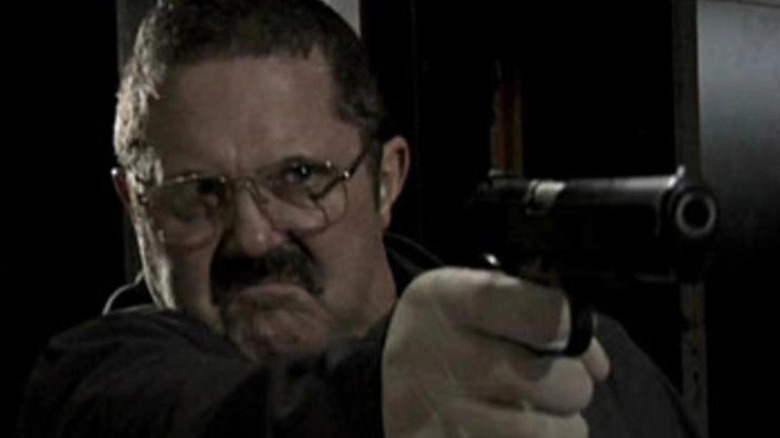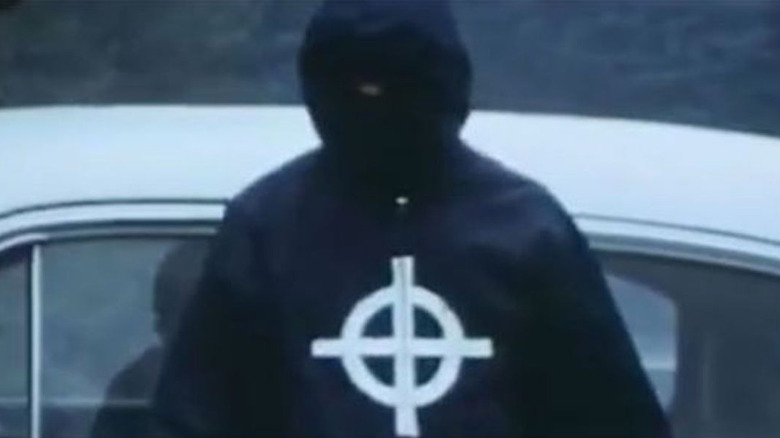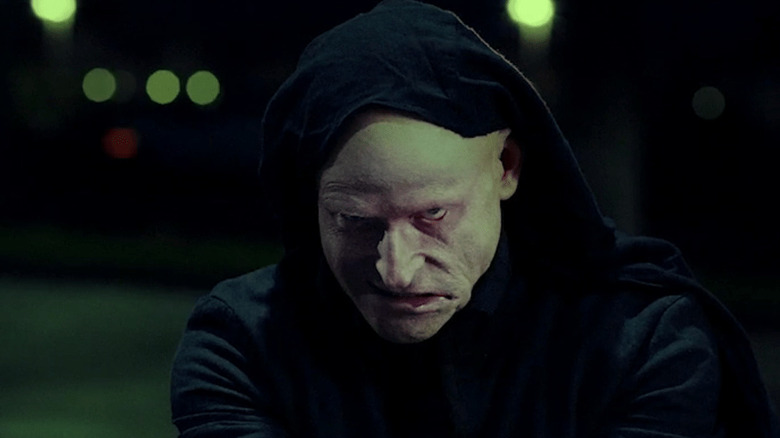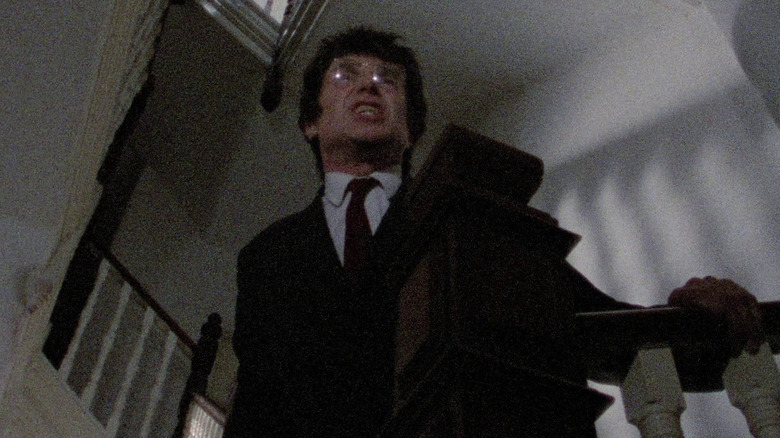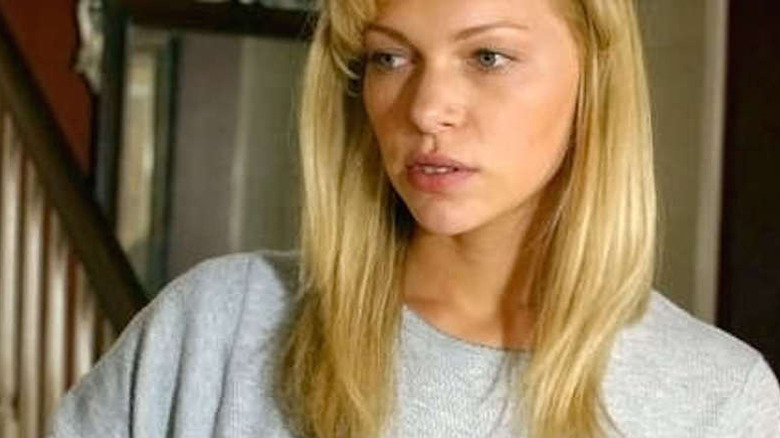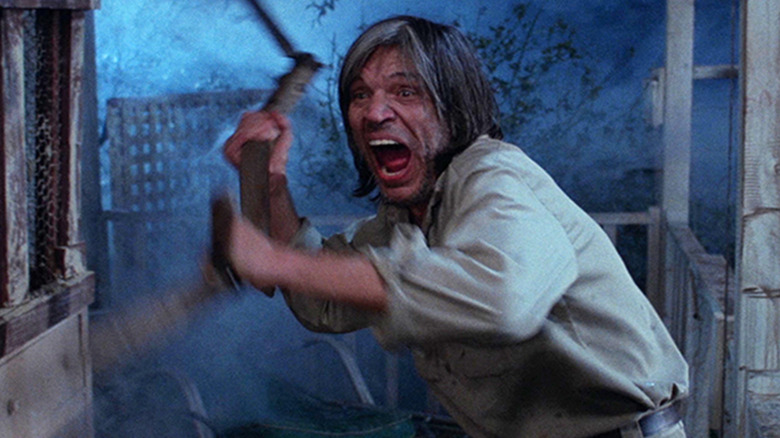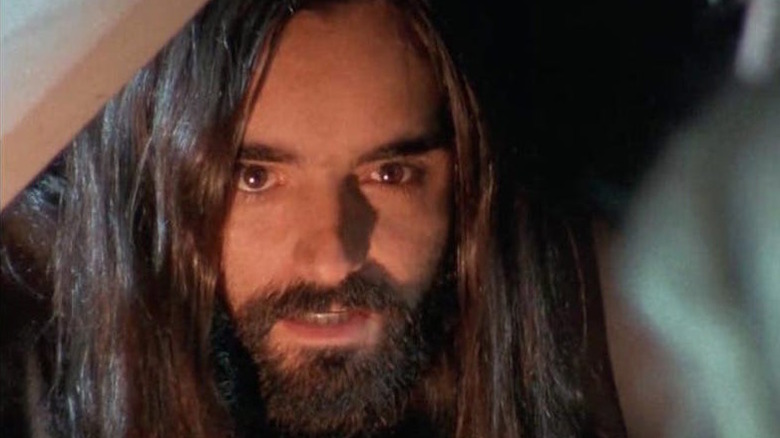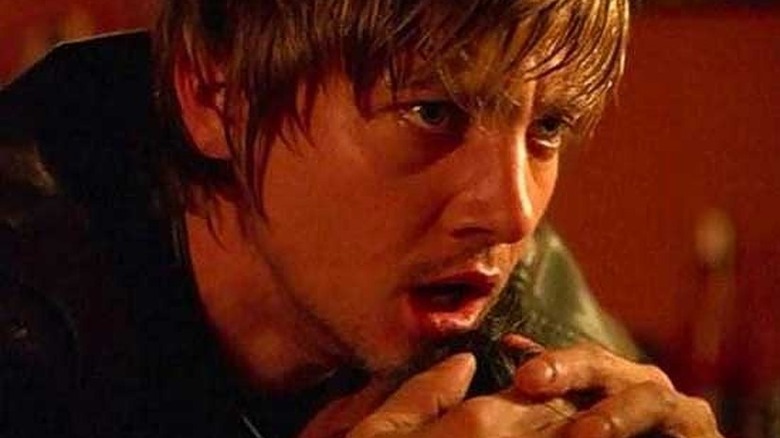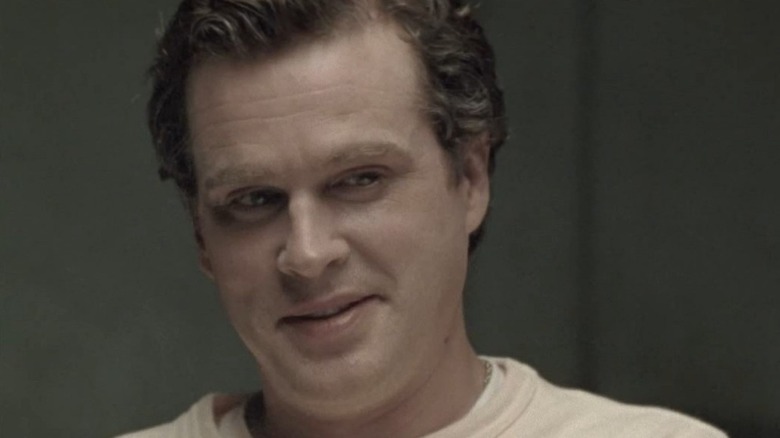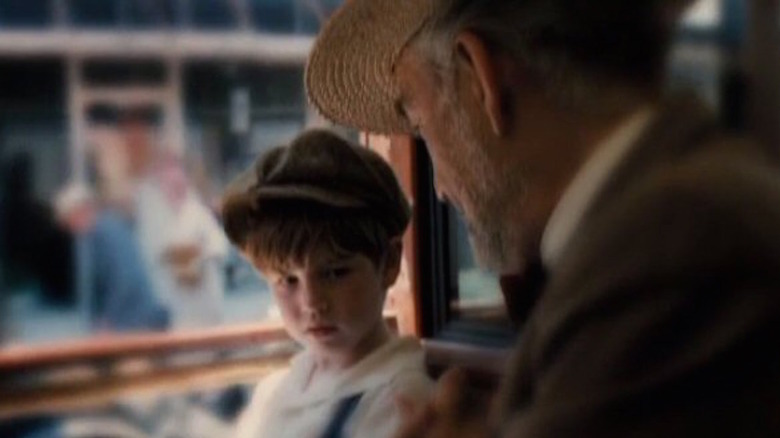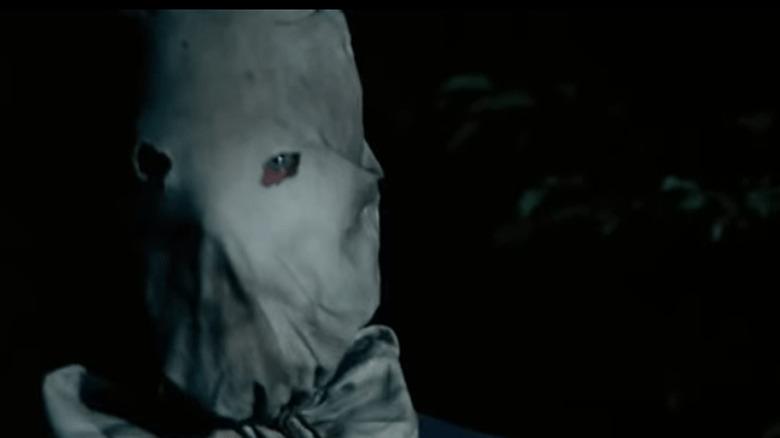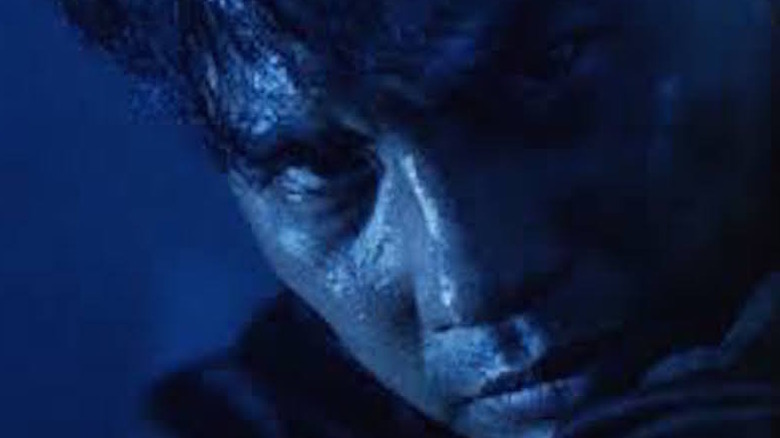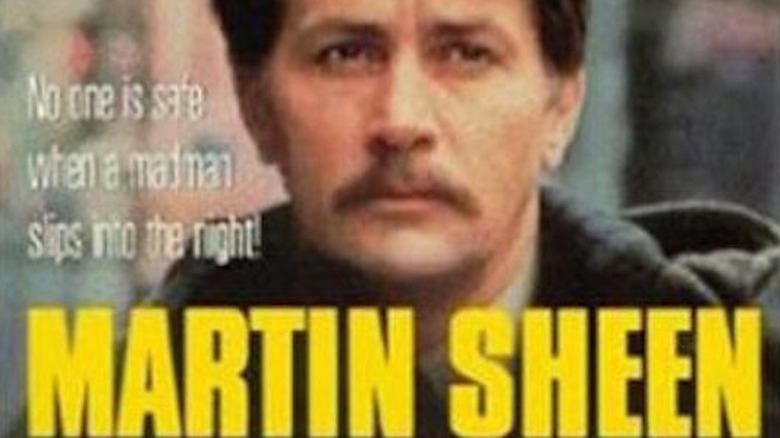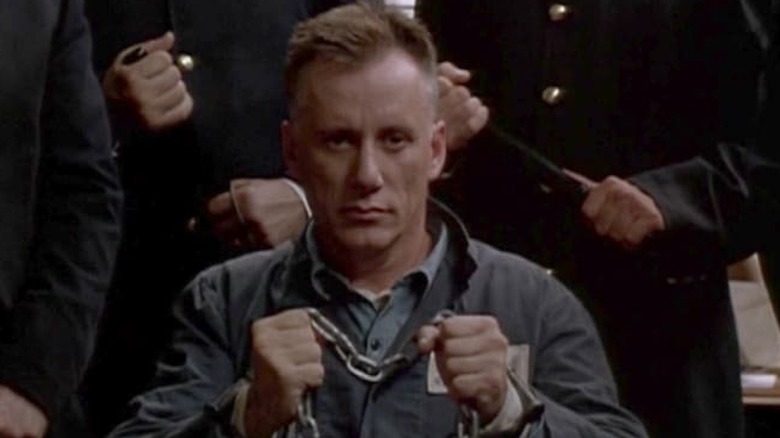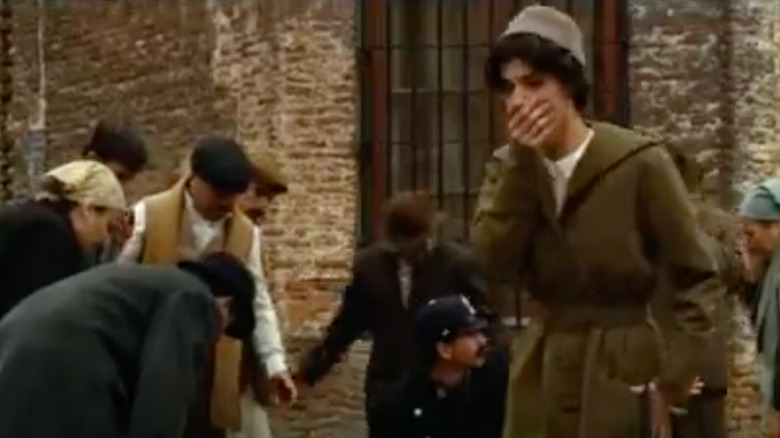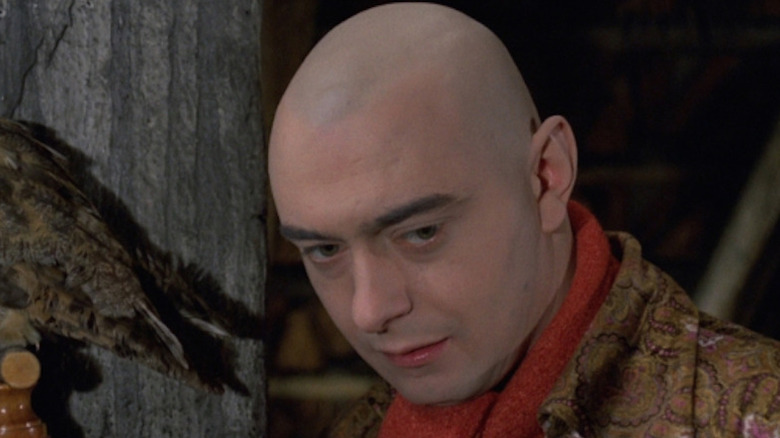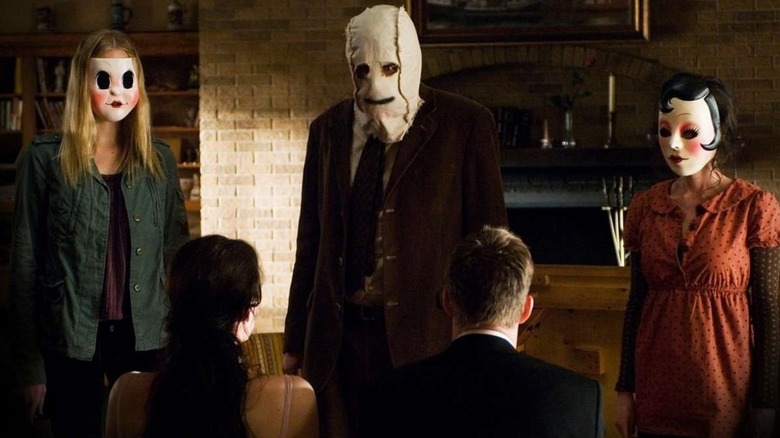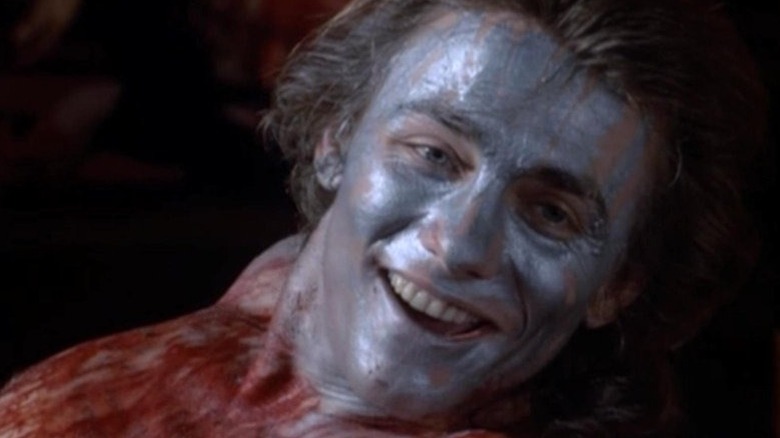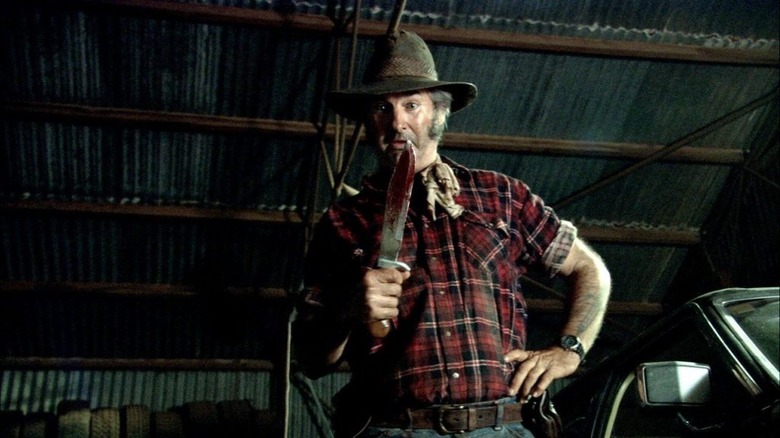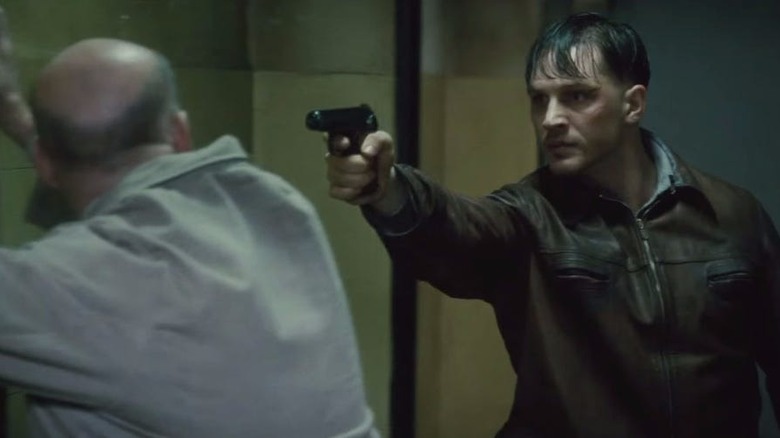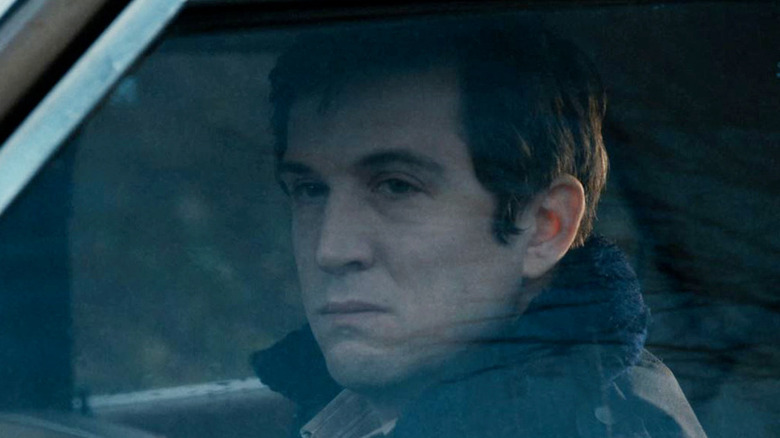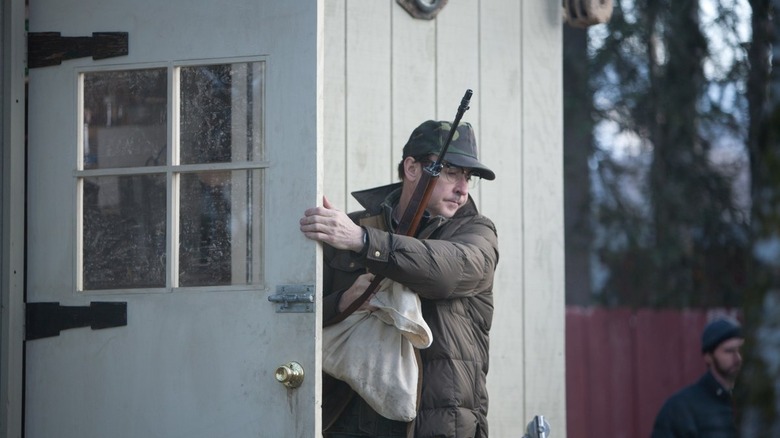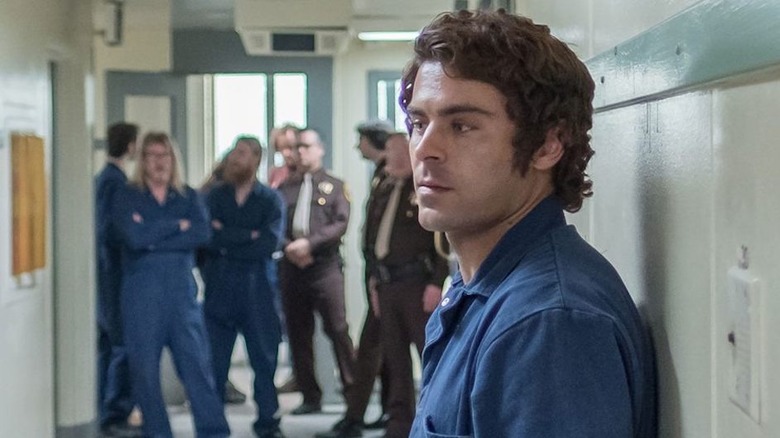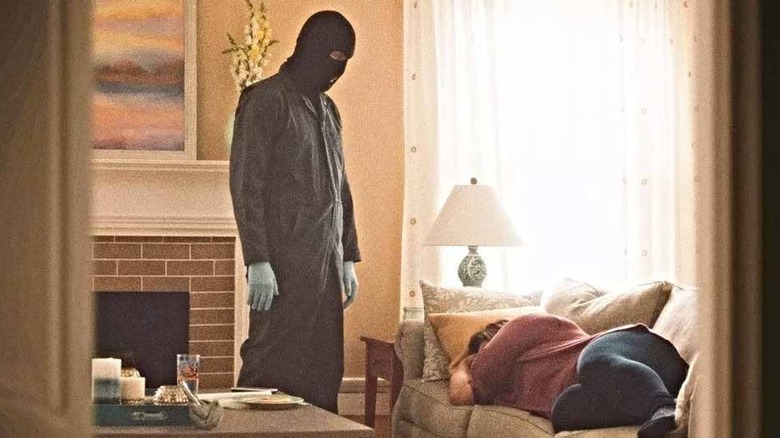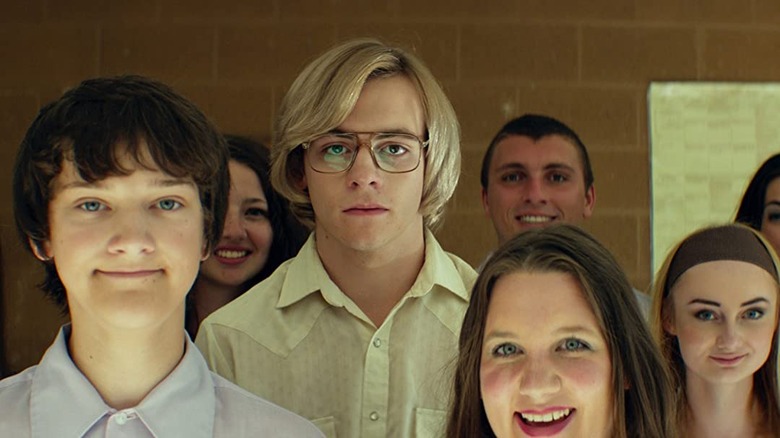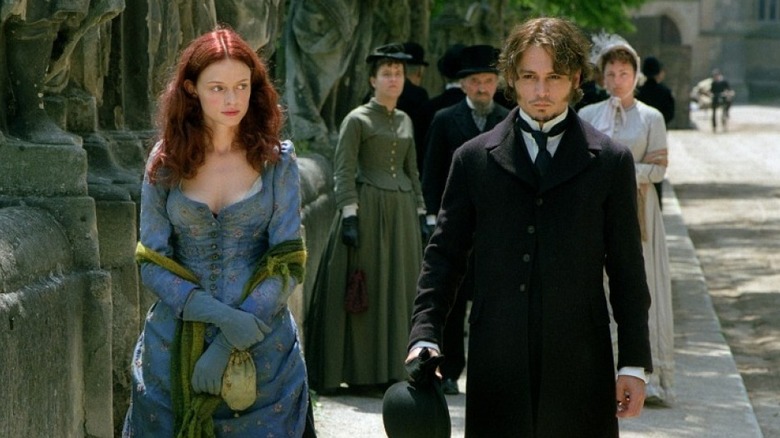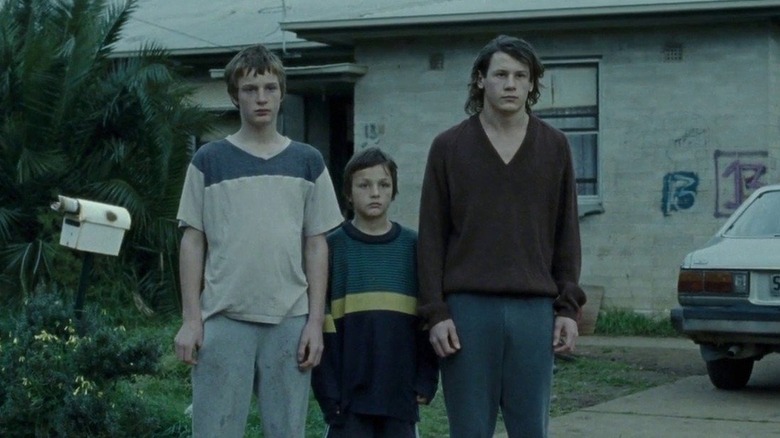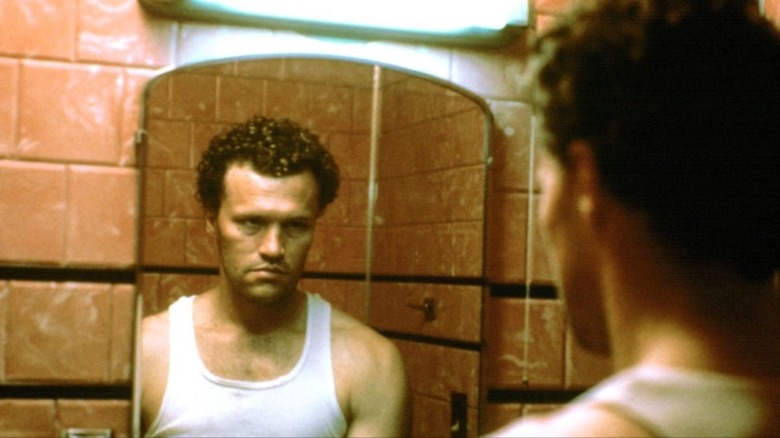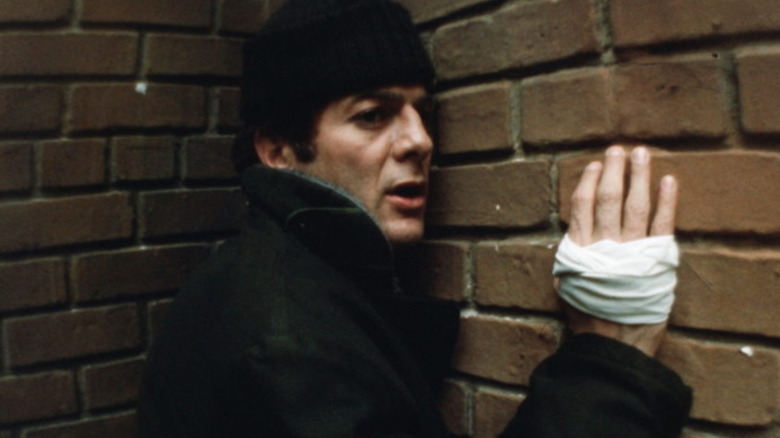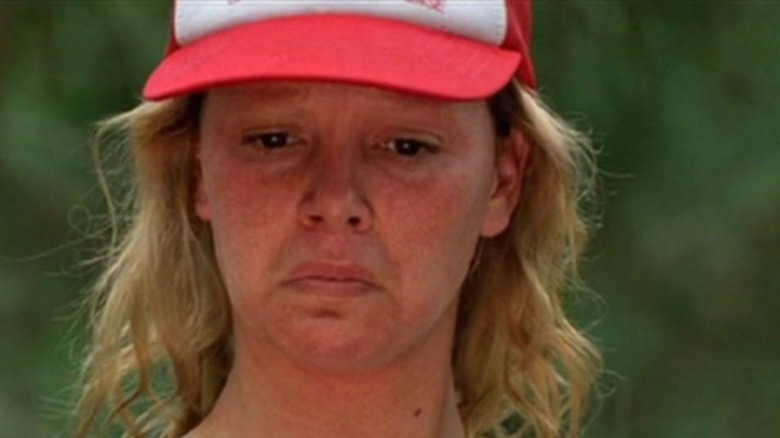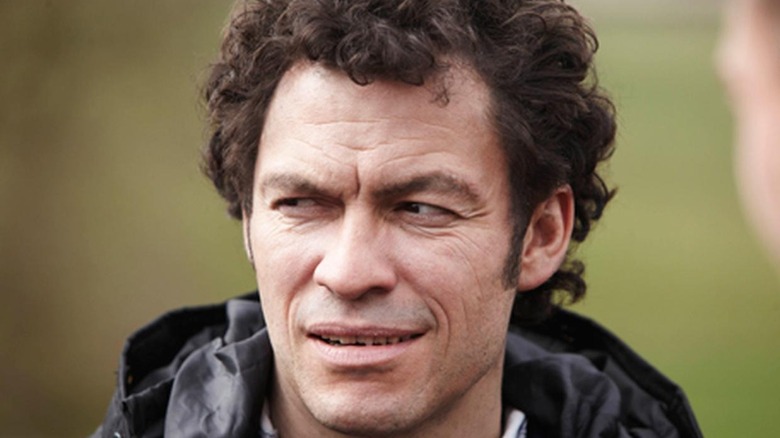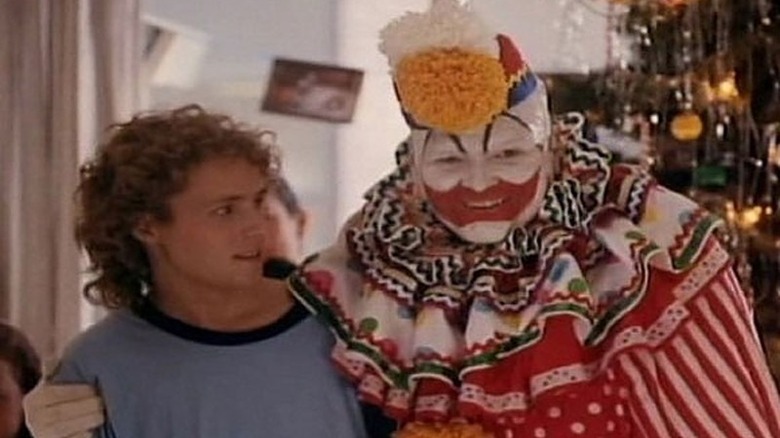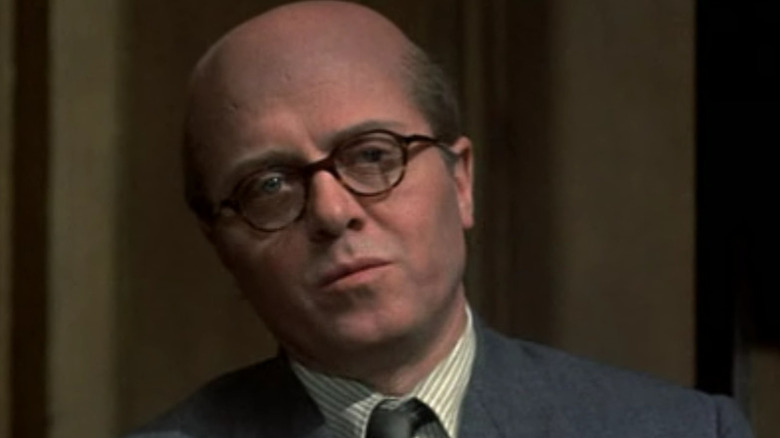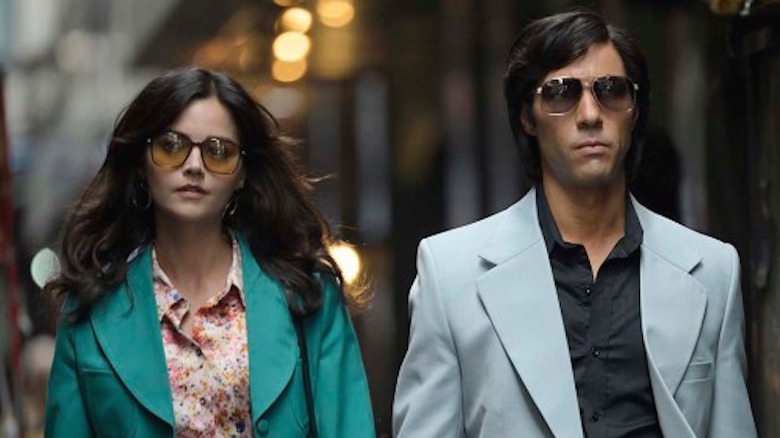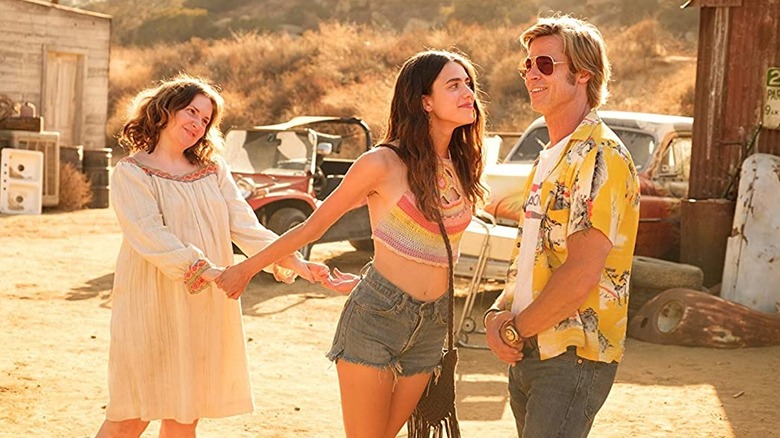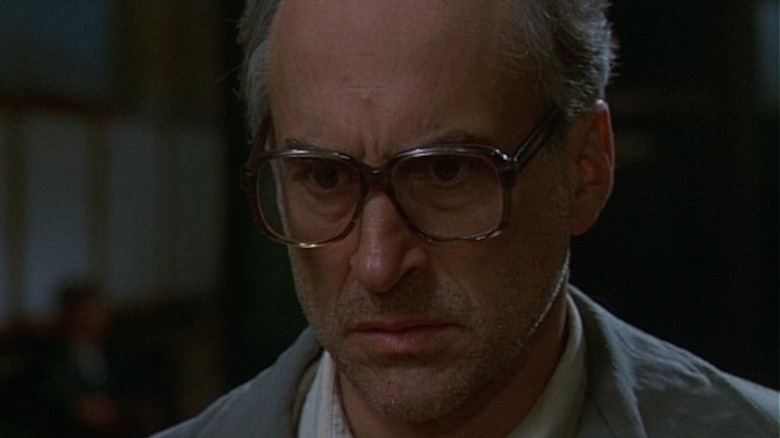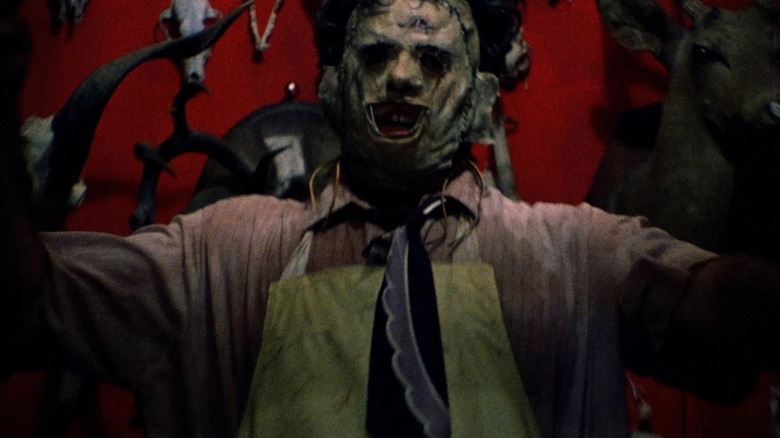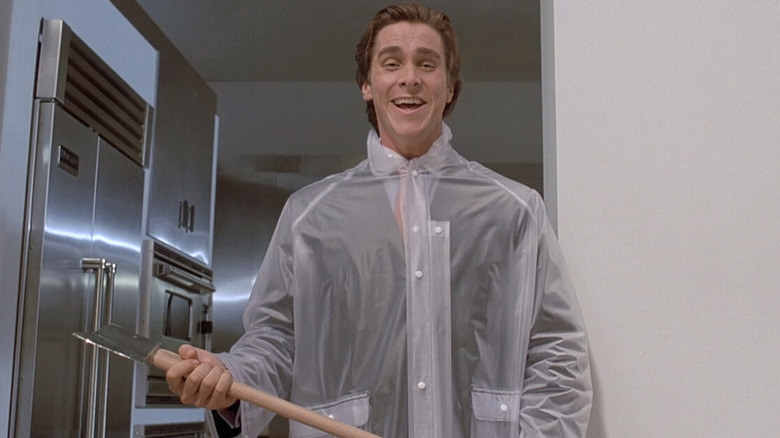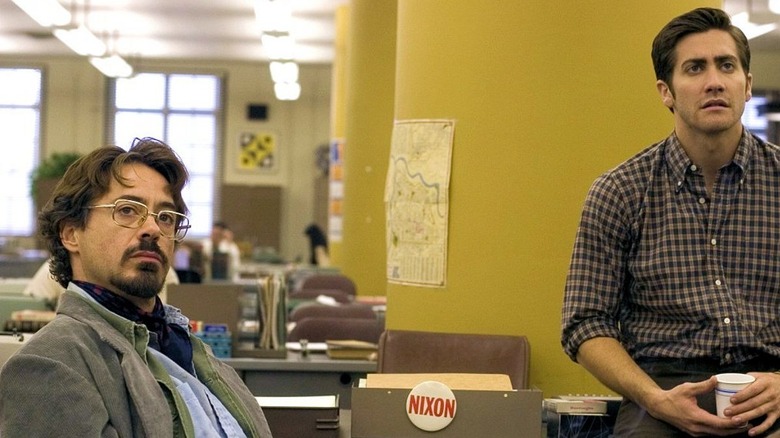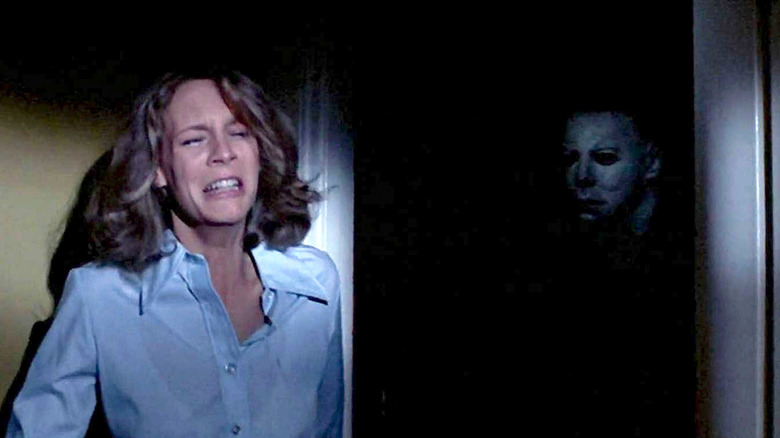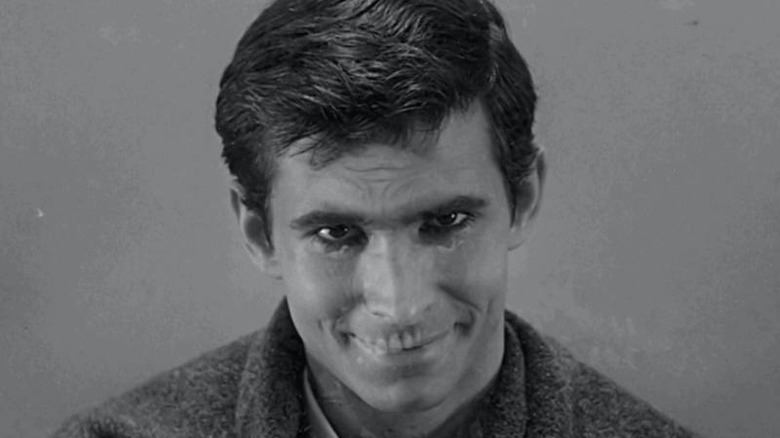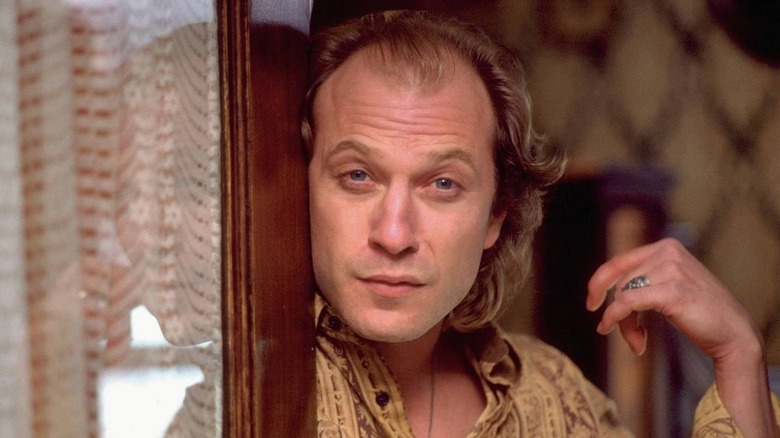42 Popular Serial Killer Movies Based On True Stories, Ranked
One of the most terrifying things about some scary movies, be they horror, thriller, or slasher, is when they claim to be based on true stories. Of course, there's a balance to be struck between inspiration drawn from the original story and the creative license of filmmakers, but no one wants to believe there is any truth, however small, to films like "The Silence of the Lambs" or "American Psycho."
In reality, though, many of these stories hit closer to home than you might think. In one especially horrific case, the same killer is responsible for three of the most well-known thrillers in cinematic history. And in pop culture at large, whether a work of art takes direct inspiration from a real killer or not, their names and stories are inescapable.
Lately, the general public has developed something of a fascination with — and even attraction to — serial killers and true crime. The real-life, real-death basis of the following films, however, should give even the most obsessed fans a great deal of pause, reminding us that there isn't always a screen separating us from humanity's greatest evils.
Based on critics' and audiences' Rotten Tomatoes scores and audience IMDb scores, the following list will tell you which true-story terrors you might be missing out on, ranked from worst to best. The three scores provide a 2-out-of-3 tiebreaker in the event that audiences and critics disagree profoundly.
The following content contains a trigger warning for descriptions of violence and sexual assault.
42. B.T.K.
Like "The Clovehitch Killer," the 2008 direct-to-video thriller "B.T.K." is a fictionalized look at Dennis Rader's two-decade reign of terror in the Midwest. That element is essentially where the connections between the two films end, because while "Clovehitch" is a frightening look at the environment of a serial killer, "B.T.K." is a by-the-books true crime/slasher title distinguished only by horror icon Kane Hodder's turn as Rader. The film's mediocrity is borne out by its ratings, which stand at 4.1/10 on IMDB and a nearly non-existent (0/10) rank on Rotten Tomatoes.
Hodder is more physically imposing than the schlubby Rader, but captures both the bland, repressive image he showed to the outside world and the obsessive menace of his secret inner life. The rest of the film is a jumble of awkward or amateurish performances, cheaply executed splatter, and plot elements that invite more laughter (Rader's assault on a pair of hormonal teenagers) than shivers. Hodder – a legendary stuntman and performer who played Jason Voorhees and Victor Crowley of "Hatchet" – deserves a better showcase for his acting abilities.
41. The Zodiac Killer
The low-budget psycho-thriller "The Zodiac Killer" isn't a particularly good movie, but it does hold a place of distinction in horror movie history. The 1971 feature was not only one of the few films based on real-life crimes that earned a release while the culprit — the cipher-writing murderer known as the Zodiac, who terrorized Northern California in the early 1970s — was still at large, but also perhaps the only film of its type made for the express purpose of catching the real killer.
Businessman-turned-director Tom Hanson believed that the Zodiac's vanity was the key to catching him, and talked Kawasaki into donating a motorcycle for a raffle at a screening. In an interview for Chris Poggiali's Temple of Schlock (via TCM), Hanson said that attendees were invited to fill out a card with their theories about the Zodiac and drop them in a box to win the bike. Inside the box was an associate of Hanson, who was comparing handwriting samples to the Zodiac's letters. Unfortunately, the scheme didn't work, though Hanson believed that he saw the Zodiac at the theater.
The behind-the-scenes story is the most interesting element of "The Zodiac Killer," which not only invents a ludicrous origin story for the murderer but also adds off-kilter comedy sequences and an appallingly misogynist rant by old-time comic Doodles Weaver. And while some of the murder sequences are chilling but accurate in terms of the real crimes, the movie is largely regarded as a turkey.
40. Smiley Face Killers
The 2020 thriller "Smiley Face Killers" refers to a contested theory by two former New York City detectives that suggested that what appeared to be the alcohol-related deaths of several young men was actually the work of one or more serial assailants. Police reported finding smiley face graffiti at crime scenes in a dozen of these cases.
"Smiley Face Killers" puts a face, so to speak, on the theory, and suggests that several shadowy figures in hoods are carrying out the murders. The film, directed by "River's Edge" director Tim Hunter and written by Bret Easton Ellis, follows a troubled college student (actor/singer Ronen Rubenstein) who believes that he is being targeted by unseen stalkers, but finds himself unable to convince others due to his history of psychological problems. Eventually, his paranoia proves correct, as he is abducted and murdered by the hooded people, which include a particularly creepy Crispin Glover.
The reaction to "Smiley Face Killers" was surprisingly negative. It's possible that the college drama — which is handled well by both Easton and the cast — sucks up much of the film's oxygen and leaves the actual horror sequences, which are genuinely spooky, as an afterthought. It's also possible that viewers attracted by Easton and Hunter on the marquee expected an angsty drama and not Crispin Glover in a hood. Unfortunately, few were left smiling by "Smiley Face Killers."
39. Cold Light of Day
Most serial killers aren't the diabolical masterminds depicted in movies. They're often totally unremarkable people whose facelessness allows them to carry out their terrible crimes without notice. Few serial killer movies depict their subjects that way, though "Henry: Portrait of a Serial Killer" focused on its protagonist's ability to pass unnoticed through the world. That's also the case for "Cold Light of Day," a low-budget UK feature about Scottish murderer Dennis Nilsen, who killed at least 12 young men in his North London flats between 1978 and 1983.
Nilsen — also the subject of the 2020 ITV miniseries "Des" with David Tennant and the Netflix documentary "Memories of Murder" — was a shabby figure locked in a lonely existence broken up by a parade of equally anonymous young men whom Nilsen killed by strangulation. He often kept the bodies in his apartments for weeks before dissecting and dismembering the bodies and then disposing of them by burning or flushing away the remains. First-time director Fhiona-Louise depicts Bob Flag as Nilsen, going about these gruesome scenes in a matter-of-fact fashion, using grimy sets and unflattering camera angles.
"Cold Light of Day" is effective in its depiction of Nilsen's warped world. The question is: do you want to see it? "Approach with caution" seems to be the underlying message here.
38. Karla
All serial killer films tread in dark territory, but the 2006 indie thriller "Karla" lets almost no daylight into its catalog of physical and mental abuse, sexual assault, and murders involving minors. However, the quality of the film itself, which has been frequently criticized in reviews, is as much a factor in its low standing amongst critics as its subject matter.
"Karla" is based on the lives and crimes of real-life Canadian couple Paul Bernardo and Karla Homolka, who were responsible for the death of three young girls, including Homolka's sister, between 1987 and 1990. Homolka's participation in the killings was the subject of considerable debate during her trial — Bernardo had committed numerous rapes prior to the murders, and was the primary force behind the torture-killings of the three women — and she initially claimed that she was forced into joining Bernardo because he had threatened her with violence. However, videotapes of the murders showed that she took a more active role.
Laura Prepon, who at the time of filming was wrapping up "That '70s Show," tackles a difficult role in playing Karla, but isn't fully up to the challenge of handling both sides of the character's mental state. She isn't helped by an underfed and clichéd script that adds a doctor character (played by Patrick Bachau of "The Grey Man") that coaxes out the story as an extended confession. It also can't decide to sympathize with or indict Homolka, offering lightweight evidence for both perspectives.
37. Eaten Alive
Just as Tobe Hooper's iconic psychopath Leatherface from "The Texas Chain Saw Massacre" drew inspiration from a real-life criminal — the murderer and grave robber Ed Gein — so too did Judd, the deranged motel owner and crocodile owner played by Neville Brand in his follow-up horror movie, 1976's "Eaten Alive." Judd was based very loosely on Joe Ball, a Depression-era bootlegger who kept live alligators at his saloon in Elmendorf, Texas, and "entertained" guests by feeding them live animals. When rumors about missing women were linked to Ball, he died by suicide; Ball was eventually connected to two murders, but unconfirmed local legends said that he was responsible for up to 20 deaths.
Despite the grisly source material, audiences and critics have never connected to "Eaten Alive." Comparisons to "Texas Chain Saw Massacre" were inevitable, and the film has a lunatic energy of its own, fueled largely by Brand's eccentric performance and the creaky croc model that consumes several supporting cast members. But it doesn't hold a candle to its horrific predecessor.
For Hooper completists, it's an intriguing curiosity, steeped in a mix of Southern Gothic atmosphere and Day-Glo lighting schemes. It grows positively manic in its final third, which finds Brand attempting to hold off the law and kill various victims located throughout the motel, including "Texas Chain Saw Massacre" alumnus Marilyn Burns, who all mount frantic and noisy escape attempts. Robert Englund also turns up as a local bad boy named Buck, whose introductory line of dialogue was copped by Quentin Tarantino in "Kill Bill."
36. The Manson Family
If you're looking for a straightforward telling of Charles Manson and the Family, Jim Van Bebber's "The Manson Family" is not that picture. That's not to say that it's poorly done — the independent film, completed over a period of 15 years, is not only powerfully acted by a cast of unknowns (including Van Bebber himself as Bobby Beausoleil), but delivers a vision of Manson's world that outstrips most other film or TV series in depicting the nightmarish conditions on the Spahn Ranch and the horror of the 1969 killings.
Though Van Bebber takes a non-linear approach to the material — framed by a secondary plotline involving a TV reporter assembling a sensationalized documentary about Manson from interviews with surviving Family members — he actually manages to present a thorough and detailed history of the group and its lifestyle with greater authenticity than we see in other depictions. He also manages to make the Family frightening again: In many Manson films, the characters feel like actors playing psycho hippies, but the lack of familiar faces in Van Bebber's cast, and the sheer intensity of their performances, feel all too real. They are just as harrowing as the hard-to-find documentary "Manson," which features terrifying interviews with real Family members, as a dramatic feature can get.
35. Dahmer
Like the killer himself, the movie "Dahmer" was extremely polarizing. Critics seemed to think the 2002 film was well worth watching, giving it a 72% fresh rating on Rotten Tomatoes — better than five out of the next six films on this list! Audiences, on the other hand, did not have a positive experience with the film: On Rotten Tomatoes it holds a 40% audience approval rating, while on IMDb it earned the lowest score on this list by far, a 5.6/10. That is a huge disparity!
That's why it's worth noting that you might want to proceed with caution when you're watching this film, as its audience scores are the lowest by far. But you definitely shouldn't write it off altogether, especially if you consider yourself something of a film buff. In that case you'll probably enjoy the non-linear, partly reverse-chronological storyline that paints the picture of a troubled young man and the unsettling, savage ways in which he exerted his disturbances on others — the (at least) 17 male victims of his murders, dismemberments, and sometimes, necrophilia and cannibalism.
It's easy to see why this film resonated more with critics than audiences: It seems to offer a rationale for one of the most monstrous serial killers in history. But it might be more nuanced than that: an expose on how pathology can evolve from trauma and survival to deviance to downright evil.
34. The Riverman
Forgotten in the avalanche of movie and television projects based on the life and crimes of Ted Bundy is "The Riverman," a 2004 A&E original production that concerned his participation in the search for Gary Ridgway, the Green River Killer. That's unfortunate, because "The Riverman" is not only a gripping thriller, but it also depicts a unique collaboration that later inspired one of the most successful serial killer films of all time.
Bruce Greenwood plays Robert Keppel, a real-life former police detective who investigated Bundy and actually interrogated him prior to his arrest in 1975. Years later, Kneppel, now a criminology professor, is called upon by police in Washington state to consult on a string of murders involving sex workers. Kneppel's investigation draws the attention of Bundy (played by Cary Elwes), who offers his own unique "perspective" on the criminal mind in exchange for photos of the crime scenes.
If the plotline sounds familiar to you, it's because the interaction between Kneppel and Bundy inspired the chilling discussions with Hannibal Lecter in Thomas Harris's "Red Dragon" and "The Silence of the Lambs." The negotiations between the two men in "The Riverman" may lack the theatrical firepower of Anthony Hopkins' performance, but Greenwood and Elwes pull off exceptional high-wire acting here, with Elwes giving his best performance to date as a monstrous narcissist whose repulsive desires lurk just below the surface of his picture-perfect face.
33. The Grey Man
It's not surprising that audience reactions to the 2007 film "The Gray Man" are muted: The drama depicts the life of one of America's most horrifying but little-known serial killers, Albert Fish, who was executed for the murder of 10-year-old Grace Budd in 1936, but was also suspected of sexually abusing, murdering, and allegedly consuming the bodies of seven others children. Director Scott Flynn addresses the gruesome crimes with considerable restraint, which may account for its low scores on Rotten Tomatoes. Fans of traditional detective stories may have been turned off by the subject matter, while those who love gory thrillers may have found it too tame.
"The Gray Man" details Fish's crimes from the perspective of a detective (Jack Conley), who spends the better part of a decade tracking down Budd's killer. His hardboiled narration feels clichéd, so the film rests largely on Belgian actor Patrick Bachau's performance as Fish to hold audience interest. Bachau does a good job of depicting both Fish's inner and outer lives. A mild-mannered elderly man with an excessive interest in helping children, Fish is plagued by memories of terrible abuse during his own childhood, which causes him to dole out ritualized punishment to himself and his victims. It's exceptionally dark material, but delivered in a palatable manner that will work for some viewers and not at all for others.
If you or anyone you know has been a victim of sexual assault, help is available. Visit the Rape, Abuse & Incest National Network website or contact RAINN's National Helpline at 1-800-656-HOPE (4673).
32. The Town That Dreaded Sundown
Though the low-budget 1976 horror film "The Town That Dreaded Sundown" has low ratings on Rotten Tomatoes, it also has a devoted cult following and even earned a remake in 2018. Much of its appeal rests on the fact that its murder set pieces are based in part on real-life murders committed in the Texarkana region in 1946 by a hooded assailant known as the Phantom Killer. Though several suspects were identified, none were ever prosecuted, and the crimes remain unsolved.
Charles B. Pierce, who directed "The Town That Dreaded Sundown," made a splash three years earlier with "The Legend of Boggy Creek," a Bigfoot thriller that was surprisingly popular with audiences. Its success allowed Pierce to hire Hollywood actors for "The Town That Dreaded Sundown," including Oscar winner Ben Johnson, cult favorite Andrew Prine, and Dawn Wells — Mary Ann on "Gilligan's Island" — as a survivor of the Phantom's attacks. Their presence lends some polish to the film, though they're undercut by comedy asides involving an inept patrolman played by Pierce. However, most of the film's energy goes into the murders, which are depicted in chilling terms: Even a seemingly ridiculous moment, in which a musician is killed when the Phantom attaches a knife to the slide on her trombone and stabs her by playing it, has a disturbing, perverse feel.
These sequences earned "The Town That Dreaded Sundown" its cult following, as well as yearly screenings in Texarkana since 2003 and a 2013 remake from Ryan Murphy and Jason Blum.
31. Dr. Lamb
One of the most notorious titles to receive Hong Kong's Category III rating — a designation given to films with graphic violence or sexual content — the torrent of murder and mutilation featured in "Dr. Lamb" may seem like the product of a screenwriter's feverish imagination, but is in fact based on a real case from the early 1980s. Lam Kor-wan was a taxi driver who kidnapped and murdered his female passengers and collected their body parts in containers at his home, which led to the media dubbing him "The Jars Murderer."
Hong Kong movie star Simon Yam plays Lam Gor-yue, a quiet family man by day who carries out gruesome murders by night on his taxi route (especially if it's raining, and it rains a lot in "Dr. Lamb"). Directors Billy Tang and Danny Lee (who also plays a police detective in the film) spare nothing in their depiction of Lam's atrocities, which range from dismemberment and cannibalism to necrophilia. This no-holds-barred approach — which is often tempered by bits of truly sick humor — has earned the film its enduring cult reputation.
There's a bit more to "Dr. Lamb" than just wall-to-wall gore: Though pure exploitation, it's technically polished and well-acted, especially by Yam, and there's a touch of commentary in its depiction of the police, who cross boundaries of their own by interrogating and even abusing Lam's family to generate a confession. But the violence and depravity are so over-the-top that they muddy all other elements of "Dr. Lamb."
30. Out of the Darkness
There's a lot of talent in front of and behind the camera in "Out of the Darkness," a TV movie take on the hunt for David Berkowitz, also known as the "Son of Sam," in the 1970s. Jud Taylor, an Emmy-nominated television director, and T.S. Cook, who wrote "The China Syndrome," handle the production side (with "French Connection" cop Sonny Grosso serving as one of the producers), while Martin Sheen (as Detective Ed Zigo) and Hector Elizondo lead a capable cast that includes Jennifer Salt, Joe Spinell ("Maniac") and briefly, Eriq La Salle and Charlie Sheen.
So why is "Out of the Darkness" such a routine telefilm? Its attention is divided. The story wants to cover the investigation, which became a desperate manhunt in the mid-1970s as Berkowitz terrorized New York City with random shootings, but it also wants to devote running time to Zigo's personal life. That storyline is dominated by Salt — a fine actress who often worked with Brian De Palma and now works as a writer/producer on "American Horror Story" and "Ratched" — as Zigo's sick wife. Either story would make a great TV movie, but "Darkness" wants to stuff both into its 94-minute running time. As a result, the whole film feels underfed and frustratingly by the numbers.
29. Killer: A Journal of Murder
James Woods gives a searing performance as Carl Panzram, a nihilistic and unrepentant criminal whose reign of terror in the early 20th century included countless cases of arson, assault, burglary (including a raid on the home of former President William H. Taft), and numerous sexual assaults against men and boys. He also murdered five men, though Panzram confessed to killing 21 and was suspected in the deaths of at least 100 individuals.
Panzram chronicled his monstrous life while awaiting his execution at Leavenworth State Prison; his manuscript informed the 1970 book "Killer: A Journal of Murder," which was made into a feature starring James Woods as Panzram in 1996. A limited theatrical release has made it something of an obscurity.
Woods's ferocious performance is the primary reason to seek out "Killer: A Journal of Murder." The framing story, which features Robert Sean Leonard as a reform-minded new guard who sees something worth saving in Panzram, is weighed down by leaden dialogue and plotting more suitable to TV movies. But Woods rises above the material. His turn as Panzram feels like the apotheosis of his screen villains, a man perpetually locked in a white-hot war with the world and himself, and determined to lose on both fronts.
28. The Mudboy
Though not a success, first-time filmmaker Jorge Algora earned critical praise from critics at home and abroad for the Spanish-Argentine production "The Mud Boy," which concerns a boy whose terrifying visions coincide with a string of child murders in Buenos Aires in the early 20th century.
Though the boy's visions are the focus of the film, its inspiration is a bizarre string of murders in Argentina between 1906 and 1912. The culprit was Cayetano Santos Godino, a disturbed young man who may have committed his first homicide at the age of 10. Nicknamed "El Petiso Orejudo" (roughly, "The Big-Eared Little Person") because of his small stature and protruding ears (due in part to malnutrition and the effects of diseases passed down by his abusive father), Godino graduated from killing animals and pyromania to arson and eventually, the murder of four young children. He spent the majority of his life in prison following his conviction in 1912 and died behind bars in 1944.
"The Mudboy" focuses less on the grisly details of the killings than the unrest they cause for Buenos Aires's barrio residents. Algora places the blame for such wanton acts of violence on the quality of life in these neighborhoods, and seeks to connect his film and its location with Fritz Lang's "M," another story of a child murderer living among the poor in a major city. Algora's killer even whistles the classical piece "In the Hall of the Mountain King" like Peter Lorre's desperate killer in "M."
27. The Tenderness of Wolves
Fans of no-budget moviemaking know German director Ulli Lommel for numerous direct-to-video horror films, many of which focus on serial killers like the "Green River Killer" and the "D.C. Sniper." However, one of Lommel's first features as a director, the 1973 German thriller "The Tenderness of Wolves," is a shocking but well-crafted film about Fritz Haarman, who assaulted and murdered at least 24 boys and young men in Germany during the 1910s and early 1920s. Haarman, who earned the nickname "the Vampire of Hanover" for his penchant for drinking his victims' blood, also inspired Fritz Lang's foundational serial killer film, "M," in 1931.
Lommel spares no quarter in depicting the nasty business of Haarman's crimes, but finds equal room to depict the killer as the product of a society in collapse: His Germany is in ruins after World War I, with citizens surviving through black market means. Everything in "The Tenderness of Wolves" is dirty and in disrepair, and in such a world, Lommel suggests, people are too busy to notice a man dumping large bundles into rivers, selling an endless supply of boys' clothes and mysterious cuts of meat to local restaurants. Even someone as obviously freaky as Haarman — a balding, goggle-eyed bundle of nerves played by the film's screenwriter, Kurt Raab — barely rates a second look from his neighbors. A deliberately ugly-looking movie about ugly business, "The Tenderness of Wolves" is probably best appreciated by hardcore horror or arthouse fans that don't mind its bleak worldview.
26. The Strangers
Honestly, it's a bit of a crime in itself to place this 2008 film so far down this list, so keep in mind that despite pretty dismal audience and critic reactions at the outset (48% for both Rotten Tomatoes scores and a 6.2/10 on IMDb), the 2008 psychological horror film "The Strangers" has become a cult classic in the intervening years.
One of the scariest things about this movie is that it was, as star Liv Tyler told Entertainment News Wire, based on not one, but two real-life events: the high-profile Manson family murders, and a series of break-ins that happened in the neighborhood director Bryan Bertino lived in as a child. It clearly made a lasting impression, and his film was unique because it refused to explain the motivations behind the home invaders' torment (his original script was even scarier and much more "Manson-esque" than the final cut).
It's part of what makes the name "The Strangers" so chillingly accurate: A stranger is someone you don't know, whose actions you can't predict or account for the way you could with someone you know. When someone is killed by a stranger, Bertino reminds us, the public may eventually find out why they were targeted, but the victim will never know: To them, it's a completely random attack. He wanted to tell that story, not the FBI-profiled explanation of motive.
That's why when asked why they were torturing the family, the strangers reply, "Because you were home."
25. Rampage
For his 1987 thriller "Rampage," director William Friedkin ("The Exorcist") drew on the ghastly crimes of Richard Chase, the "Vampire of Sacramento" — so named for his penchant for drinking the blood and consuming the remains of his victims — who killed six people over the course of a month between 1977 and 1978. Chase had a long history of psychopathic behavior, which the defense attempted to use during his trial in 1979 as a means of avoiding capital punishment. The jury found him guilty of first-degree murder and sentenced him to death, though he ultimately died by suicide in 1980.
The argument for using such a defense is at the heart of "Rampage," which follows the trial of a serial killer played by Alex MacArthur. Despite his heinous crimes, which follow Chase's pattern of murder and drinking blood, his lawyers seek to have him declared not guilty by reason of insanity. The prosecutor (played by Michael Biehn), who is an opponent of capital punishment, finds himself reconsidering his stance as a result of the crimes, which the killer details with bland detachment.
Friedkin brings palpable terror to the murder sequences, but can't do much to elevate the courtroom scenes above the level of episodic TV. Even Friedkin himself has a muted response to his film, which struggled to score a theatrical release for five years after its studio, DEG, went bankrupt. "I don't think I hit my own mark with that," he told Vulture in 2013.
24. Wolf Creek
Critics and audiences on Rotten Tomatoes liked this 2005 film just a little more than they liked "The Strangers" (53% and 49%, respectively, with the same 6.2 IMDb score), but many people in both circles felt like it was pretty exploitative of a genuinely horrific story. But if being truly repelled is your thing, this might be the serial killer movie for you.
"Wolf Creek" was based on the Backpacker Killer, whose real name was Ivan Milat. Milat never confessed to the murders before he died in prison, but that didn't stop people from finding a morbid fascination in his story, which came to light when the bodies of seven backpackers (all tourists or people traveling through the area of New South Wales, Australia) were discovered in a remote forest.
Marketed as being based on real events, the film shocked audiences with just how violent and depraved it really was. Roger Ebert said he wanted to "walk out of the theater and keep on walking." But for horror addicts looking for another endurance test, that almost sounds like an invitation.
23. Child 44
Adapted from the 2008 novel of the same name by Tom Rob Ford, "Child 44" was inspired by the crimes of Andrei Chikatilo, who assaulted, mutilated, and murdered at least 52 women and children in Soviet Russia, Ukraine, and Uzbekistan between 1978 and 1990. Despite a high-profile cast led by Tom Hardy and featuring Gary Oldman and Noomi Rapace, critics and audiences alike were unimpressed by the film.
The key complaint about the film seems to be that Oscar-nominated screenwriter Richard Price ("The Night Of") wasn't able to replicate the suspenseful pace and plotting of Ford's novel. Its massive size, coming in at 400 pages, may have been a contributing factor, since the end result feels bloated and over-long, following far too many characters, plot threads, and commentary on life under Communism instead of focusing on the killer. It also makes the mistake of requiring its actors to adopt Russian accents, which makes it feel more like a Cold War melodrama than a modern thriller. Given that Hardy's normal speaking voice can sometimes be a challenge for American moviegoers, adding an accent nearly renders him incomprehensible.
22. Next Time I'll Aim for the Heart
Chances are that only those viewers with an encyclopedic knowledge of serial killers know Alain Lamare and the film about his crimes, "Next Time I'll Aim for the Heart." Though it earned two Cesar nominations, French writer/director Cedric Anger's 2014 feature has a limited presence outside of its home country. That's most likely due to its lack of wide availability, which is unfortunate, since "Next Time I'll Aim for the Heart" is a chilling look at how serial killers are often free to carry out their crimes in full view of the public.
Lamare — who is named Franck Neuhardt in "Next Time I'll Aim for the Heart" — was a gendarme who murdered young women while on patrol between 1978 and 1979. Actor/director Guillaume Canet ("Tell No One") plays Neuhardt as a clearly disturbed individual but also a loyal, rulebook-following police officer, which eliminates him from suspicion in the eyes of his superiors and fellow officers, who are too busy competing with each other to catch the killer.
Nearly everyone in his life, from his parents to the woman (Ana Giradot) who falls in love with him, seems to turn a blind eye to his psychopathic behavior, which is made even more maddening by the fact that Neuhardt isn't particularly clever or subtle when carrying out his crimes (he runs over one victim in his patrol car). "Next Time I'll Aim for the Heart" is a disturbing (and disturbingly prescient) look at the factors that can allow society's most dangerous individuals to operate without fear of punishment.
21. The Frozen Ground
With the star power of Nicolas Cage, John Cusack, and Vanessa Hudgens, you'd think that this mystery-thriller from 2013, "The Frozen Ground," would have performed a little bit better with critics and audiences (who, on Rotten Tomatoes, gave respective scores of 61% and 50%). Though it was arguably nothing special based on these scores and its 6.4/10 rating on IMDb, the film is as solid as the frozen ground itself, from the performance of Cage to the procedural plot. It enjoyed renewed and more positive attention when it began streaming in 2020.
The literally chilling film is based on an Alaskan serial killer named Robert Hansen, also known as the Butcher Baker, who actually hunted down 17 women in the Alaskan wilderness like some kind of depraved predator. Though he used multiple weapons, including a knife and a gun, the wilderness itself was arguably its own instrument of fear.
The movie serves as a chilling account of the struggles that sex workers, who are often the targets of violence, experience with the often discriminatory attitudes of law enforcement. Hudgens' character, Cindy Paulson, is a prostitute who escapes Hansen's clutches after he abducts and assaults her ... But because of her profession and the fact that she lies about her age, no one wants to take her side against the upstanding family man Robert Hansen, until a state trooper works with her to track him down as his spree continues.
If you or anyone you know has been a victim of sexual assault, help is available. Visit the Rape, Abuse & Incest National Network website or contact RAINN's National Helpline at 1-800-656-HOPE (4673).
20. Extremely Wicked, Shockingly Evil, and Vile
When Zac Efron became the new face of Ted Bundy on Netflix in 2019, with Lily Collins playing Bundy's longtime girlfriend Liz Kendall, audiences were excited. Pop culture had become obsessed with the serial killer phenomenon in the preceding years, so the time seemed ripe for one of history's most famous madmen to make an appearance.
Despite critical disappointment (a dissatisfied Rotten Tomatoes score of 54%) and a lackluster performance with audiences — though audiences on both Rotten Tomatoes (57%) and IMDb (6.7/10) still liked this movie better than "The Frozen Ground" — one element that drew consistent praise was Efron's acting. Bundy himself was known as a handsome, beguiling stranger who enticed his female victims, and the former Disney movie star plays the part well.
For those who aren't obsessed, the lengthy title of the film, "Extremely Wicked, Shockingly Evil, and Vile," is a reference to the words of the judge who sentenced Bundy to death. The film itself is more of a biographical drama than a thriller, based on Kendall's memoir. Unlike other films in this list, we don't really get up-close-and-personal with Bundy's horrific side: We see hints of it interspersed with the façade he expertly showed the world, and this duality is one of the vilest parts of all.
19. The Clovehitch Killer
No less of a horror authority than Stephen King voiced his support on social media for "The Clovehitch Killer," a tense, slow-boiling thriller from 2018 based loosely on the crimes of serial killer Dennis Rader, who murdered 10 individuals between 1974 and 1991. He wasn't alone in his praise: The indie feature, directed by Duncan Skiles and written by Christopher Ford ("Spider-Man: Homecoming") received praise from both critics and audiences alike. It's doubly impressive that this reception was achieved without a widespread theatrical release from IFC Midnight or any major stars beyond Dylan McDermott as a family man with a terrible secret.
While some films that are inspired by Rader, such as the low-budget 2008 feature "B.T.K" with Kane Hodder, focus on the grisly details of his crimes — Rader's sadistic behavior was summed up by his self-appointed moniker "BTK" ("bind, torture, kill") — "Clovehitch" instead looks at the crimes of Don Burnside (McDermott) from the perspective of his son, played by Charlie Plummer. Like Rader's own children, Plummer's character is unaware that his father is the "Clovehitch Killer," so named for the knot he used to bind his victims. But when he discovers his father's cache of "souvenirs" — photographs of the victims and bondage magazines — he is faced with a terrible choice: stop his father at any cost or risk further deaths, including his own. "Clovehitch" hits harder because it finds the emotions under the horror.
18. My Friend Dahmer
Critics in general seem to be much bigger fans of the Jeffrey Dahmer story than audiences, at least in the cases of both Dahmer flicks on this list. Whether it's because it's uncomfortable or because it just hasn't been told in a way that resonates yet, 2017's "My Friend Dahmer" enjoyed a Certified Fresh rating of 86% among critics on Rotten Tomatoes, but only a barely-fresh rating of 61% among audiences (with IMDb viewers offering a similarly middling rating of 6.2).
In the case of this film, maybe it was a little weird to see former Disney Channel star Ross Lynch playing a particularly depraved serial killer. (We got the same thing in Zac Efron's portrayal of Ted Bundy, but "My Friend Dahmer" goes much deeper into the killer's monstrosity.) The critical consensus classifies the film as both "empathetic" and "deeply troubling," which automatically puts audiences in the difficult position of considering the darkness inside themselves.
We get to see patterns in Jeffrey Dahmer that we can probably recognize in ourselves, without thinking of ourselves as monsters: obsession, maladaptive coping, and deviant fascinations, to name a few. If you want a window into the mind of someone who has done unthinkable things — if you want to get a little uncomfortable — "My Friend Dahmer" might be exactly what you're looking for.
17. From Hell
It's been done time and time again, but with Johnny Depp as the lead investigator in London's Jack the Ripper murders, there was the potential to unearth something great in 2001's "From Hell." Unfortunately, the film hit a roadblock that so many do: With such a well-known story, one that has essentially reached the status of legend, the source material commands a high expectation that can be incredibly difficult to reach.
While the performances of the leads and the visual spectacle of the film were generally applauded, critics in general found the story itself "dull," and not scary at all. It only earned a 57% score on Rotten Tomatoes, though audiences liked it better (66% on Rotten Tomatoes and 6.8/10 on IMDb). That's a pretty disappointing appraisal considering that the story of a serial killer who stalked the streets of London, cutting throats and removing organs, is pretty scary by default.
The title of the film comes from a letter allegedly sent by the Ripper to George Lusk and his Whitechapel Vigilance Committee, who were trying to apprehend the killer. It opened with, "From hell," like a business letter might open with, "From the desk of..." Attached was half a human kidney (the author claimed to have fried and eaten the rest). The scares sure seem built-in ... It's up to you whether the critics are right or not.
16. The Snowtown Murders
While the audience score for 2011's "The Snowtown Murders" tied that of the previous entry, the critical score is so much greater that it eked out a higher position. This powerful film is a disturbing "endurance test," as the critical consensus on Rotten Tomatoes puts it. It's certainly an investment, and the two-hour runtime and brutal subject matter means that you have to go through a lot to get your payout.
What draws people to this movie about what were also known as the "bodies in the barrels" murders is this very brutality in the midst of what is really a well-made film. The tale of three killers — John Bunting, Robert Wagner, and James Vlassakis — is beautifully told, but at the same time unwatchable. Making it all the way through this paradoxical experience is a badge of honor even among hardcore horror fans.
It's safe to assume that label probably doesn't apply to all of the viewers who scored the film a 66% with audiences on Rotten Tomatoes and a 6.6./10 on IMDb. If you consider yourself a fan of art horror films, your rating might look a little different.
15. Henry: Portrait of a Serial Killer
Here's where it starts getting good, quantitatively speaking. The top 10 films on this list are all above a 7.0 on IMDb and not below a 70% on both Rotten Tomatoes scores, so whether you consider yourself a critical viewer or just love to binge-watch serial killer movies, you'll find something you love in these films — like "Henry: Portrait of a Serial Killer," the 1986 profile of a serial killer named Henry Lee Lucas, also known as The Confession Killer. (You may also recognize him from the 2017 Netflix documentary series "The Confession Tapes.")
Some parts of the killer's nickname are more accurate than others: Lucas was definitely more confessor than killer. The man confessed to more murders than he committed, so his total count may be as few as three or as high as the triple digits. Even if lying is a much lighter crime than murder, it's terrifying to think that someone loved killing so much that they wanted credit for potentially hundreds of victims more than they actually had.
"Henry: Portrait of a Serial Killer," however, treats Lucas as if he had more than his three confirmed victims. Through his story, in which he also advises his friend and fellow killer Otis (based on convicted killer Ottis Toole), we see one version of events in which Lucas was as prolific as he said he was, and his disputed victims and different M.O.s were all a part of his design.
14. The Boston Strangler
Prior to tackling the horrific story of John Christie in "10 Rillington Place," Richard Fleischer explored the psychological makeup of a serial killer in 1968's "The Boston Strangler." The documentary-styled drama, anchored by a chilling performance by Tony Curtis as the accused killer, Albert De Salvo, was the subject of intensely negative press at the time of its release, with critics from the New York Times and other outlets describing it as an exercise in poor taste. However, modern viewers seem to have reversed that opinion and recognize "The Boston Strangler" as an expertly crafted thriller.
While the subject matter in "The Boston Strangler" is disturbing — De Salvo confessed to (but was never tried for) sexually assaulting and killing 13 women in Boston in 1963 and 1964 — Fleischer takes exceptional care to remove any sense of exploitation from the dramatization of the crimes through judicious editing and pacing. He also makes excellent use of a split screen to show both sides of the manhunt for the killer; when the Boston police finally apprehend De Salvo, the technique becomes a highly effective metaphor for De Salvo's bisected personality. Curtis is particularly effective in his interrogation scenes with Henry Fonda (as police detective John Bottomly), and rightly deserved his Golden Globe nomination.
13. Monster
You've never seen Charlize Theron like this. The actress's 2003 transformation for the role of Aileen Wuornos in "Monster" is just one of the many shocks this film delivers. Theron plays a sex worker who has endured abuse at the hands of many of her male clients, and who kills one of them in self-defense after an assault. The trauma of this experience and Wuornos' fight for survival lead her on a misguided vigilante quest during which she kills and robs half a dozen more clients.
This portrayal is raw and riveting, rated 81% fresh among both audiences and critics on Rotten Tomatoes and a 7.3 on IMDb. It carries a heavy trigger warning due to its nuanced portrait of trauma and its unnerving, "deglamorized" portrayal of a serial killer.
It seems that Christina Ricci maintained the dark edge she inherited from her iconic portrayal of Wednesday Addams, the morbid but ingenious daughter of the anti-ideal Addams clan in 1991's "The Addams Family" and its 1993 sequel, "Addams Family Values." In "Monster," Ricci gives a compelling performance as Wuornos' girlfriend Selby, a fictionalized version of her real-life partner, Tyria Moore. Together, the two actors dive deeply into a very difficult story.
12. Appropriate Adult
It's unfortunate that the miniseries "Appropriate Adult," which aired on ITV in the United Kingdom in 2011, appears to be largely unknown to American television audiences. Originally airing in two parts, "Adult" stars Emmy- and Oscar-nominated actress Emily Watson ("Chernobyl") as real-life social worker Janet Leach, who was assigned to serve as an "appropriate adult" — a guardian of sorts who assists vulnerable witnesses during police questioning under English law — for a high-profile case. To her dismay, she discovers that the suspect is Fred West (played by Dominic West from "The Affair" and "The Wire"), who alongside his wife Rosemary (Monica Dolan) was convicted of 12 murders and a horrific campaign of torture and sexual abuse carried out against numerous women and even their own children.
What follows is an uncomfortably intimate look at the psychological manipulation used by serial killers to draw in their victims. Leach, who is called in because West is functionally illiterate, proves the weaker of the two when faced with West's mix of childish affection, helplessness, and flattery. She eventually becomes another of West's casualties as his influence upends her family life and professional standing. All three leads give exceptional performances, with West — who's fitted with dental prosthetics to match Fred's toothy smile — the most notable by tempering his signature charm with a chilling deviousness.
11. To Catch A Killer
Why do clowns scare people so much? The American public has been terrorized by "evil clown" sightings intermittently since at least the year 1981, and many of us probably remember the most recent spate of appearances in the year 2016. In 1985, Stephen King published his notorious novel It, about a malevolent supernatural evil that takes many forms, most notably that of Pennywise the Dancing Clown. In the horror genre at large and in the world of phobias, clowns have become a classic source of terror.
Is it a coincidence that John Wayne Gacy, more commonly known as the Killer Clown, was active throughout the 1970s, shortly before the idea of an evil clown came into vogue? "To Catch A Killer" profiled the hunt for the party clown who frequently performed at children's birthdays, was active in his local political community, and murdered at least 33 young men and boys.
The chilling game of cat-and-mouse in the 1992 film was quite well-received by audiences, who rated the film 88% on Rotten Tomatoes and 7.4/10 on IMDb. Though it lacks a critical score, the high-profile case and the mystique of the killer clown are sure to titillate audiences.
10. 10 Rillington Place
The primary purpose of many serial killer films is obvious: They want to frighten you. And 1971's "10 Rillington Place," about the English murderer John Christie, certainly achieves that goal. This is thanks largely to Richard Attenborough's unnerving performance as the outwardly unremarkable but secretly monstrous Christie, who killed eight people, including his own wife and an infant, between 1943 and 1953.
But Fleischer is equally concerned about the poisonous impact that Christie's crimes have on the victims and their families, and the law's often shortsighted response to such horrible actions. One of Christie's victims was his neighbor, Beryl Evans, who turned to Christie to help terminate a pregnancy (Christie had limited medical knowledge from military service). Christie instead strangled Beryl and her young daughter, telling her husband Timothy that she had died during the botched procedure.
The impressionable Timothy — played by a BAFTA-nominated John Hurt — fled London, only to be caught and coerced into a confession. He was hanged for the crime, and though posthumously exonerated, Fleischer delivers no sense of relief from the miscarriage of justice. The information is tacked on at the end of the film, where we also learn that Christie was executed. The brevity of this info is deliberate: It's too late to do anything more than acknowledge that Christie's depraved actions sent an innocent man to his death. In that sense, "10 Rillington Place" carries great emotional weight along with its chilling storyline.
If you or someone you know may be the victim of child abuse, please contact the Childhelp National Child Abuse Hotline at 1-800-4-A-Child (1-800-422-4453) or contact their live chat services.
9. The Serpent
From the 1950s through the 1970s, thousands of Western counterculture adherents followed a path from Europe to South Asia, seeking enlightenment and adventure on a limited budget. A handful of them never reached their final destination after crossing paths with Charles Sobhraj, a serial killer who robbed and murdered travelers on the "hippie trail" between 1975 and 1976. The 2021 BBC One/Netflix miniseries "The Serpent" details Sobhraj's diabolical scheme, which resulted in the alleged deaths of 20 individuals, as well as his long flight from justice, which finally ended in 2004.
Many viewers were lured to "The Serpent" by its visual aesthetic: French actor Tahar Rahim and "Doctor Who" alum Jenna Coleman — who play Sobhraj and girlfriend Marie-Andree Leclerc, respectively — cut stylish figures draped in '70s couture, while location shooting throughout Thailand lends a riot of color to the production. Lurking behind these hypnotic images is the cruelty of Sobhraj's scheme, which involved luring young travelers with promises of drugs and easy money, slowly poisoning them, and then stealing their passports to crisscross the world and avoid authorities.
Sobhraj left carnage in his wake on two continents, ruining the lives of associates and pursuers alike, and managed to avoid capture or lengthy imprisonment for nearly four decades. Today, he's a free man after serving 19 years in a Nepal prison.
8. Once Upon A Time ... In Hollywood
Though this film by Quentin Tarantino (like an earlier Tarantino film, 2009's "Inglourious Basterds") depicts an alternate history revenge fantasy in which the real-life bad guys violently get their due, the fictionalized account in 2019's "Once Upon A Time ... In Hollywood" is at its heart based upon real events. These include not only the infamous Manson family murders in L.A. in 1969, but the final moments of Hollywood's golden age.
Because of its whimsical portrayal of this era, and the absurdity and excess with which it alters the course of events in terms of the killings, Tarantino's film stands apart from others in the "based-on-a-real-serial-killer" category because it is more of a comedy-drama than horror, slasher, or thriller. That's not to say we're spared any of Tarantino's trademark violence, but audiences in general have agreed that the pace of this film is much more of a slow burn than the usual Tarantino fare.
It's also a bit less popular than some of his classics. Critic scores landed at 85% on Rotten Tomatoes (which by default outranks "To Catch A Killer," which has none), while audiences gave it a 70% there and a 7.6/10 on IMDb. Maybe that's because the film's climax seems to make up for the more relaxed atmosphere of the rest of the film — it's a lot to take in at once, but incredibly memorable if you're up for it.
7. Citizen X
While "Child 44" flirts with the awful story of Andrei Chikatilo, the 1995 HBO telefilm "Citizen X" tackles the case head-on and delivers a more straightforward and suspenseful crime drama along with a streak of political commentary. Response to "Citizen X" was also more favorable than Daniel Espinosa's film, and it ended up netting seven Emmy and two Golden Globe Award nominations, with Donald Sutherland winning one of each.
Chief among the film's positives is an excellent cast: The film favors skill and believability over marquee value, and benefits hugely from Stephen Rea as the lead investigator, Sutherland as his cagey superior, and Max von Sydow as a wise psychiatrist who provides a crucial profile of the killer (played by Jeffrey De Munn of "The Walking Dead"). Battling corruption and bureaucracy is a time-worn element of countless police dramas, and like Tom Hardy, Rea has to swim against party diehards who refuse to accept a serial killer in the Soviet Republic. Again, delivery is vital. Espinosa swings for big reveals and action sequences, but writer/director Chris Gerolmo knows what all cops know: Patience, attention to detail, and determination get results.
6. The Texas Chain Saw Massacre
There have been many incarnations of the "Texas Chainsaw" franchise, from sequels to reimaginings. Tobe Hooper's 1974 original "The Texas Chain Saw Massacre," however, has arguably never been equaled. It sits at an 89% critical rating on Rotten Tomatoes, while audiences on that site and IMDb rated it 82% and 7.5/10, respectively. It's a wild ride that's based on a real serial killer — one who also inspired the films that sit at #1 and #2 on this list.
That killer was Ed Gein, also known as the Butcher of Plainfield or the Plainfield Ghoul. It's hard to decide which is more terrifying, the idea that Leatherface came out of someone's twisted imagination, or the idea that such a monster actually existed in the real world. Unfortunately, the latter is closer to the truth in this critically-acclaimed audience favorite. Though they don't share the operating state of Texas, a psychotic family, or the choice weapon of a chainsaw, Ed Gein and Leatherface do share a fashion sense: They like to wear and make keepsakes out of human body parts, especially skin.
The "realism" of "The Texas Chain Saw Massacre" doesn't stop at the fact that it was "based on a true story," though. The actors used were intentionally obscure, and the cinematography was reminiscent of a documentary. It is shocking to see such horrific events portrayed as almost too real, and even more shocking when you discover how "real" some of the story actually is.
5. American Psycho
Inspired by his heroes (Ted Bundy, Edmund Kemper, and Donald Trump), Patrick Bateman polarized critics and audiences in 2000 with his story in "American Psycho." Critics gave it a 70% approval rating on Rotten Tomatoes, while audiences gave it an 85% and a 7.6 on IMDb. This divide arose not just because of the off-putting nature of its violence, but because of the genuine polarization of its genre placement: It felt too creepy to be a comedy and too funny (in an absurd way) for its own horror.
The author of the novel that inspired the film, Bret Easton Ellis, read "every book on Ted Bundy" in preparation for his own. Bateman can be seen as modeled after Bundy in that he was a charming, attractive man on the surface but the picture of evil, lacking a conscience or empathy, on the inside.
This controversial film almost qualified as another outlet for the likeness of Ed Gein, whom Bateman quotes directly in the film when he talks about how when he sees a woman on the street, part of him wants to show her a nice time and the other part wonders what her head looks like on a stick.
The quote is a memorable one, and it was attributed by Bateman to a killer that many people in pop culture would have recognized ... But this quote was actually spoken by a different killer, Edmund Kemper — whose targets, like Bateman's, were primarily women.
4. Zodiac
As surreal as his films can be, David Fincher did an impeccable job with "Zodiac" in 2007, a film inspired by a nonfiction book about the infamous Zodiac Killer. The fact that the case remains unsolved means that the film itself focuses more on the manhunt for the as-yet-unidentified killer, with a star-studded team of Mark Ruffalo, Jake Gyllenhaal, and Robert Downey, Jr. leading the charge in a film that critics scored as 89% fresh on Rotten Tomatoes.
The film's effect is especially impressive considering how dialogue-driven much of the action is: It's more anxiety-inducing than gory, with a real sense of atmosphere that captures the spirit of the times — and the specter of the Zodiac Killer. He was known for taunting the police with everything from letters to bloodstained clothing — and the ciphers he sent them were supposed to contain the clues to his identity.
In a way, Fincher was the perfect person to direct a story that doesn't have a true conclusion, as he is known for his own inconclusive endings. The film, which audiences rated 77% on Rotten Tomatoes and 7.7/10 on IMDb, spans a whole decade and while it makes suggestions, it keeps us guessing — just as the public is still guessing decades later.
3. Halloween
Like "The Texas Chain Saw Massacre," "Halloween" was another 1970s horror masterpiece (1978, to be exact) that has seen many reincarnations and reinventions throughout the years. The inspiration for Michael Myers actually comes from a killer whose name you've heard before: Edmund Kemper.
Remember him? He's the one whose quote was misattributed by Patrick Bateman in "American Psycho" to the serial killer Ed Gein. Kemper was much more prolific than Gein, and like Michael Myers, he started with a member of his own family. In Kemper's case, it was his grandmother (and shortly after, his grandfather, because he didn't want to deal with his grandfather's questions and anger about his grandmother). Like Michael Myers, Kemper then spent over a decade in a psychiatric facility.
Of course, "Halloween" is widely regarded as one of the scariest and most iconic horror movies of all time, achieving a 96% critical rating and 89% audience rating on Rotten Tomatoes, along with a 7.7 IMDb score. It's scary enough even if you didn't know it was based on a serial killer who lured young female hitchhikers into his vehicle with his non-threatening vibe, then killed them and took their bodies home to perform unspeakable acts on them.
But the supernatural elements of Michael Myers that make him a little less believable are much less reassuring when you know that there was a truly evil guy like that out there.
2. Psycho
The story of Norman Bates is regarded by many as the "mother" of serial killer stories, pun intended. Robert Bloch, author of the 1959 novel "Psycho" — which inspired Alfred Hitchcock's film of the same name the following year — based the troubled hotel proprietor and murderer on real serial killer Ed Gein. A seminal work in the horror genre in every way, the subsequent film by many accounts established the slasher genre for the first time — and earned itself a 96% Rotten Tomatoes score among critics, a 95% audience score and an 8.5/10 on IMDb.
Though we know that the Plainfield Ghoul has been the inspiration for many serial killer movies, "Psycho" was the first time his story rose to prominence in cinematic pop culture. So what do he and Norman Bates have in common? Oddly enough, though Gein is commonly referred to as a serial killer, he was only ever proven to have killed two people (grave robbing was his preference).
What he and Norman Bates share is more of a sensibility: their atypical psychologies and their bizarre predilections for wearing dead women's skin. Gein's goal was to literally crawl inside a woman to cope with the grief of losing his mother. That's a creepy enough premise and it's executed perfectly by Hitchcock's trademark suspenseful atmosphere, regardless of the fact that Norman Bates' kill count in "Psycho" barely surpasses that of Gein himself.
1. The Silence of the Lambs
The best serial killer movie to be inspired by a real story is a doozy: One of its villains reportedly took inspiration from six different serial killers! But the "true story-inspired" killer in "The Silence of the Lambs" isn't its most notorious name, Hannibal Lecter: It's "Buffalo Bill," who skins his female victims. Though his rampage was inspired by many real-life stories, his desire to make a "woman suit" takes direct cues from the repeat star of this list, Ed Gein.
With all of his pop culture appearances, you'd never guess that Ed Gein terrorized the dead much more than the living. Buffalo Bill certainly prefers the latter instead: The scene in which he stalks Clarice in night vision goggles as she stumbles around in the dark was arguably the most terrifying scary movie scene of 1991. The film itself was an instant classic, tying with "Psycho" among critics and audiences on Rotten Tomatoes at 96% and 95%, respectively, and eking out a lead on IMDb at 8.6/10.
"The Silence of the Lambs" elevated the horror genre by becoming the first (and only) film under that label to win the Academy Award for Best Picture: Only six have ever been nominated. But as this list makes clear, there are plenty of high-caliber horror movies whose stories are not only terrifying, but (to an extent) true.
